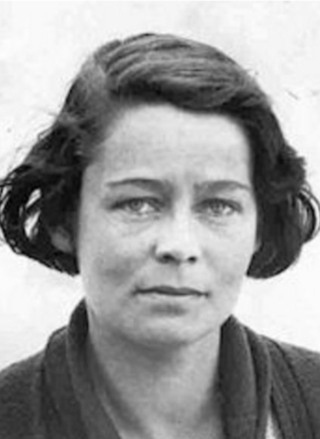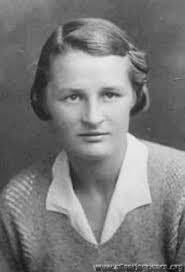Marion AliceOrr, CM was a pioneering Canadian aviator who was the first woman to run a flying school. She served with the Air Transport Auxiliary during World War II and was awarded the Order of Canada in 1986.

The Air Transport Auxiliary (ATA) was a British civilian organisation set up at the start of the Second World War with headquarters at White Waltham Airfield in Berkshire. The ATA ferried new, repaired and damaged military aircraft between factories, assembly plants, transatlantic delivery points, maintenance units (MUs), scrapyards, and active service squadrons and airfields, but not to naval aircraft carriers. It also flew service personnel on urgent duty from one place to another and performed some air ambulance work. Notably, around 10% of its pilots were women, and from 1943 they received equal pay to their male colleagues, a first for the British government.

Joan Lily Amelia Hughes, MBE was a World War II ferry pilot and one of Britain's first female test pilots. She was considered a capable instructor and flew everything except flying boats.

Diana Barnato Walker MBE FRAeS was a pioneering British aviator. In World War II, she became one of the first women pilots of the Air Transport Auxiliary, flying 80 types of aircraft and delivering 260 Spitfires. In 1963, she became the first British woman to break the sound barrier, flying at Mach 1.6, which also represented a world air speed record for women.

Eleanor Lettice Curtis was an English aviator, flight test engineer, air racing pilot, and sportswoman.
Constance Ruth Leathart was a British female pilot who flew Royal Air Force aircraft on transit flights in World War Two in the Air Transport Auxiliary.

Hazel Jane Raines was an American pioneer aviator and flight instructor with the Civilian Pilot Training Program. During World War II, she was part of the first group of United States women to fly military aircraft, which they did in a war zone for the civilian British Air Transport Auxiliary. She was later a member of the civilian contract labor Women Airforce Service Pilots. After the war, she taught instrument training in Brazil. When President Harry S. Truman authorized the integration of women into the military, she served with the Women's Air Force and was based in Texas, Alabama, and finally London until her death. Raines was the first woman in Georgia to earn a pilot's license, and has been inducted into both the Georgia Aviation Hall of Fame and the Georgia Women of Achievement.

Joy Lofthouse was a British pilot having joined the Air Transport Auxiliary (ATA) as an ab initio pilot in December 1943. She went on to fly Spitfires and bombers for the Air Transport Auxiliary, and was one of only 168 "Attagirls" who served.

Mary Ellis was a British ferry pilot, and one of the last surviving British female pilots from the Second World War.

Vera Elsie Strodl Dowling was a Danish pilot who gained fame in the Second World War as the only Scandinavian woman to fly for the RAF's Air Transport Auxiliary. Later, based in Alberta, Canada, she instructed pilots under the Commonwealth Training Programme. In May 2000, she was honoured with membership of Canada's Aviation Hall of Fame.

Elsie Joy Davison was a Canadian-born British aviator and airline director. She started flying herself in 1929. After becoming a director of an aircraft company in 1936, she died serving with the Air Transport Auxiliary in 1940, becoming the first female British aviator to die in World War II.

Gabrielle Ruth Millicent Patterson was a British aviator who worked for the Air Transport Auxiliary. She was Britain's first woman flying instructor.

Mona Renee Vera Ernesta Forward was a British pilot and one of the eight founding pilots who started the women's section of the Air Transport Auxiliary.

Margaret Cunnison was a Scottish aviator and the first Scottish woman flying instructor. She was one of the first women to join the Air Transport Auxiliary.

Winifred Crossley was an aviator who was the first woman to be checked out on a Hurricane fighter. She was one of the First Eight, the initial group of women pilots to join the Air Transport Auxiliary.

Mary de Bunsen was a British Air Transport Auxiliary pilot and author.

June Constance Howden, also known as Judy Howden was a New Zealand aviator and one of five New Zealand women who joined the Air Transport Auxiliary (ATA) during World War Two.

Stefania Cecylia Wojtulanis-Karpińska, was a Polish aviator. She was a sports pilot in the inter war period and was a Captain in the Polish Air Force. She flew in the British Air Transport Auxiliary (ATA) in the Second World War, when she was known as Barbara Wojtulanis. She was one of the first two Polish woman pilots to join the British Air Transport Auxiliary, the other being Anna Leska.

Anna Leska was a Polish pilot certified to fly gliders, balloons and aeroplanes. She was one of the two first Polish woman pilots to join the British Air Transport Auxiliary, the other being Stefania Wojtulanis-Karpińska.

Honor Salmon was a First Officer pilot in the British Air Transport Auxiliary (ATA) during World War Two. She was one of fifteen women pilots who lost their lives flying in the service of the ATA.





















